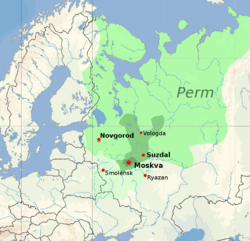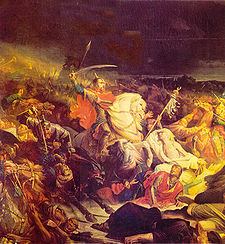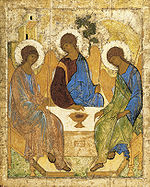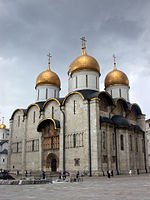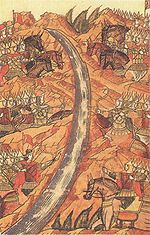- Grand Duchy of Moscow
-
Grand Duchy of Moscow
Великое Княжество Московское
Velikoye Knyazhestvo MoskovskoyeTributary of the Golden Horde until 1480 ← 
←
←
←
1283–1547  →
→Territorial development between 1390 and 1530 Capital Moscow Language(s) Old East Slavic Religion Russian Orthodoxy Government Absolute monarchy Grand Duke - 1283–1303 Daniel (first) - 1462–1505 Ivan III (the Great) - 1505–1533 Vasili III History - Established 1283 - Tsardom proclaimed 22 October 1547 Currency Ruble The Grand Duchy of Moscow (Russian: Великое Княжество Московское, Velikoye Knyazhestvo Moskovskoye), also known in English as Muscovy, was a late medieval Rus' principality centered on Moscow, and the predecessor state of the early modern Tsardom of Russia.
The Grand Duchy of Moscow grew from just 20,000 square kilometers in 1300 to 430,000 in 1462, 2.8 million in 1533, and 5.4 million by 1584.[1] It is taken to originate with Daniel I who inherited the town in 1283, eclipsing and eventually absorbing its parent duchy of Vladimir-Suzdal by the 1320s. The power of Moscow expanded further, annexing the Novgorod Republic in 1478 and the Grand Duchy of Tver in 1485. It remained tributary to the Golden Horde (the "Tatar Yoke") until 1480. Ivan III, during his 43-year reign, further consolidated the state, campaigning against his major remaining rival power, the Grand Duchy of Lithuania, and, by 1503, had tripled the territory of Muscovy, adopting the title of tsar and "Ruler of all Rus'". By his marriage to the niece of the last Byzantine emperor, he established Muscovy as the successor state of the Roman Empire, the "Third Rome". Ivan's successor Vasili III was also militarily successful, gaining Smolensk from Lithuania in 1512, pushing Muscovy's borders to the Dniepr River. Vasili's son Ivan IV (the later Ivan the Terrible) was an infant at his father's death in 1533. He was crowned in 1547, assuming the title of tsar together with the proclamation of Tsardom of Russia (Царьство Руское).
Contents
Origin
When the Mongols invaded the lands of Kievan Rus', Moscow was an insignificant trading outpost in the principality of Vladimir-Suzdal. Though Mongols burnt down Moscow in the winter of 1238 and pillaged it in 1293, the outpost's remote, forested location offered some security from Mongol attacks and occupation, and a number of rivers provided access to the Baltic and Black Seas and to the Caucasus region.
More important to Moscow's development into what became the state of Moscow however, was its rule by a series of princes who collaborated with Mongols and provide their policy. The first ruler of the principality of Moscow, Daniel I (d. 1303), was the youngest son of Alexander Nevsky of Vladimir-Suzdal. He started to expand his principality by seizing Kolomna and securing the bequest of Pereslavl-Zalessky to his family. Daniel's son Yuriy (also known as Georgiy) controlled the entire basin of the Moskva River and expanded westward by capturing Mozhaisk. He then forged an alliance with the overlord of the Russian principalities, Uzbeg Khan of the Golden Horde, and married the khan's sister. He was allowed by the khan to claim the title of Grand Duke of Vladimir-Suzdal, a position which allowed him to interfere into the affairs of the Novgorod Republic to the north-west.
Yuriy's successor, Ivan I (r. 1325–40), managed to retain the title of Grand Duke by cooperating closely with the Mongols and collecting tribute and taxes from other Russian principalities on their behalf. This relationship enabled Ivan to gain regional ascendancy, particularly over Moscow's chief rival, the northern city of Tver, which rebelled against the Horde in 1327. The uprising was subdued by the joint forces of Mongols and Muscovites. Ivan was reputed to be the richest person in Russia, as his moniker "Kalita" (literally, the "moneybag")(Moss 2005) testifies. He used his treasures to purchase land in other principalities and to finance construction of stone churches in the Kremlin. In 1327, the Orthodox Metropolitan Peter transferred his residence from Kiev to Vladimir and then to Moscow, further enhancing the prestige of the new principality.
Dmitri Donskoi
Ivan's successors continued gathering the lands of Rus' to increase the population and wealth under their rule. In the process, their interests clashed with the expanding Grand Duchy of Lithuania, whose subjects were predominantly East Slavic and Orthodox. Grand Duke Algirdas of Lithuania allied himself by marriage with Tver and undertook three expeditions against Moscow (1368, 1370, 1372) but was unable to take it. The main bone of contention between Moscow and Vilnius was the large city of Smolensk.
In the 1350s, the country and the royal family were hit by the Black Death. Dmitry Ivanovich was aged nine, when his parents died and the title of Grand Duke slipped into the hands of his distant relative, Dmitry of Suzdal. Surrounded by pagan Lithuanians and Muslim nomads, the ruler of Moscow cultivated an alliance with the Russian Orthodox Church, which experienced a resurgence in influence, due to the monastic reform of St. Sergius of Radonezh.
Educated by Metropolitan Alexis, Dmitri posed as a champion of Orthodoxy and managed to unite the warring principalities of Russia in his struggle against the Horde. He challenged the Khan's authority and defeated his commander Mamai in the epic Battle of Kulikovo (1380). However, the victory did not bring any short-term benefits; Tokhtamysh in 1382, sacked Moscow hoping to reassert his vested authority over his vassal, the Grand Prince, and his own Mongol hegemony, killing 24,000 people.
Nevertheless, Dmitri became a national hero, the memory of Kulikovo Pole made the Russians start believing in their ability to end Tatar domination and become a free people. Dmitri successfully overcame the stigma of collaborating with the Tatars which had been attached to Moscow for decades. In 1389, he passed the throne to his son Vasily I without bothering to obtain the Khan's sanction.
Vasily I and Vasily II
History of Russia 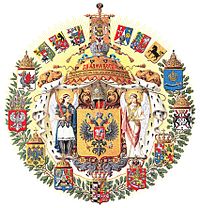
This article is part of a seriesVolga Bulgaria (7th–13th) Khazar Khaganate (7th–10th) Rus' Khaganate (8th–9th) Kievan Rus' (9th–12th) Vladimir-Suzdal (12th–14th) Novgorod Republic (12th–15th) Mongol invasion (1220s–1240s) Tatar Yoke (13th–15th) Grand Duchy of Moscow (1340–1547) Tsardom of Russia (1547–1721) Russian Empire (1721–1917) Russian Provisional Government / Russian Republic (1917) Russian SFSR / Soviet Union (1917–1991) Russian Federation (1992–present)
Russia Portal
Vasily I (r. 1389–1425) continued the policies of his father. After the Horde was attacked by Tamerlane, he desisted from paying tribute to the Khan, but was forced to pursue a more conciliatory policy after Edigu's incursion on Moscow in 1408. Married to the only daughter of Grand Duke Vytautas of Lithuania, he attempted to avoid open conflicts with his powerful father-in-law, even when the latter annexed Smolensk. The peaceful years of his long reign were marked by the continuing expansion to the east (annexation of Nizhny Novgorod and Suzdal, 1392) and to the north (annexation of Vologda, Veliky Ustyug, and Perm of Vychegda, 1398). Nizhny Novgorod was given by the Khan as a reward for Muscovite help against a rival. [1]
The reforms of St. Sergius triggered a cultural revival, exemplified by the icons and frescoes of the monk Andrei Rublev. Hundreds of monasteries were founded by St. Sergius's disciples in distant and inhospitable locations, including Beloozero and Solovki. Apart from their cultural function, these monasteries were major landowners, who could control economy of the adjacent region. In effect, they served as outposts of Moscow influence in the neighboring principalities and republics. Another factor responsible for the expansion of Grand Duchy of Moscow was its favorable dynastic situation, when each sovereign was succeeded by his son, while rival principalities were plagued by dynastic strife and splintered into ever smaller polities. The only lateral branch of the House of Moscow, represented by Vladimir of Serpukhov and his descendants, was firmly anchored into Moscow Duchy.
The situation changed with the ascension of Vasily I's successor, Vasily II (r. 1425–62). Before long his uncle, Yuri of Zvenigorod, started to advance his claims to the throne and Monomakh's Cap. A bitter fratricidal conflict erupted and rocked the country during the whole reign. After Yuri's death in 1432, his claims were taken up by his sons, Vasily Kosoy and Dmitry Shemyaka, who pursued the Great Feudal War well into the 1450s. Although he was ousted from Moscow on several occasions, taken prisoner by Olug Moxammat of Kazan, and blinded in 1446, Vasily II eventually managed to triumph over his enemies and pass the throne to his son. At his urging, a native bishop was elected as Metropolitan of Moscow, which was tantamount to declaration of independence of the Russian Orthodox Church from the Patriarch of Constantinople (1448).
Ivan III
History of Udmurtia 
This article is part of a seriesVolga Bulgaria Mongol invasion Golden Horde Khanate of Kazan Ar begs Muscovy Kazan Governorate Udmurt Autonomous Oblast Udmurt ASSR Udmurt Republic
Udmurt Republic Portal
Great Bulgaria Khazars Volga Bulgaria Kipchaks Mongol invasion Golden Horde Khanate of Kazan Muscovy Kazan Governorate Idel-Ural State Tatar ASSR Republic of Tatarstan
Tatarstan Portal
Outward expansion of the Grand Duchy in the 14th and 15th centuries was accompanied by internal consolidation. By the 15th century, the rulers of Moscow considered the entire Russian territory their collective property. Various semi-independent princes of Rurikid stock still claimed specific territories, but Ivan III (the Great; r. 1462–1505) forced the lesser princes to acknowledge the grand prince of Moscow and his descendants as unquestioned rulers with control over military, judicial, and foreign affairs.
Moscow gained full sovereignty over a significant part of the ethnically Russian lands by 1480, when the Tatars' Golden Horde overlordship ended officially after the Great standing on the Ugra river, and by the beginning of the 16th century virtually all those lands were united, including the Novgorod Republic (annexation of 1478) and the Grand Duchy of Tver (annexation of 1485). Through inheritance, Ivan was able to control the important Principality of Ryazan, and the princes of Rostov and Yaroslavl' subordinated themselves to him. The northwestern city of Pskov consisting of city and few lands surrounding it remained independent in this period, but Ivan's son, Vasili III (r. 1505–33), later conquered it.
Having consolidated the core of Russia under his rule, Ivan III became the first Moscow ruler to adopt the titles of tsar and "Ruler of all Rus'". Ivan competed with his powerful northwestern rival Lithuania for control over some of the semi-independent former principalities of Kievan Rus' in the upper Dnieper and Donets river basins. Through the defections of some princes, border skirmishes, and a long, inconclusive war with Lithuania that ended only in 1503, Ivan III was able to push westward, and Moscow state tripled in size under his rule.
The reign of the tsars started officially with Ivan IV of Russia (Ivan the Terrible), the first monarch to be crowned Tsar of Russia, but in practice it started with Ivan III, who completed centralization of the state (traditionally known as the gathering of the Russian lands) at the same time as Louis XI did the same in France.
Court
The court of the Moscow princes combined ceremonies and customs inherited from Kievan Rus with those imported from the Byzantine Empire and Golden Horde. Some traditional Russian offices, like that of tysyatsky and veche, were gradually abolished in order to consolidate power in the hands of the ruling prince. A new elaborate system of court precedence, or mestnichestvo, predicated the nobleman's rank and function on the rank and function of his ancestors and other members of his family. The highest echelon of hereditary nobles was composed of boyars. They fell into three categories:
- Rurikid princes of Upper Oka towns, Suzdal, Rostov, Yaroslavl, etc. that lived in Moscow after their hereditary principalities had been incorporated into Duchy of Moscow (e.g., Shuisky, Vorotynsky, Repnin, Romodanovsky);
- Foreign princes from Lithuania and Golden Horde, claiming descent either from Grand Duke Gediminas or from Genghis Khan (e.g., Belsky, Mstislavsky, Galitzine, Trubetskoy);
- Ancient families of Moscow nobility that have been recorded in the service of Grand Dukes from the 14th century (e.g., Romanov, Godunov, Sheremetev).
Rurikid and Gediminid boyars, whose fathers and grandfathers were independent princelings, felt that they were kin to the grand prince and hence almost equal to him. During the times of dynastic troubles (such as the years of Ivan IV's minority), boyardom constituted an internal force which was a permanent threat to the throne. An early form of the monarch's conflict with boyarstvo was the oprichnina policy of Ivan the Terrible.
During such conflicts, Ivan, Boris Godunov, and some later monarchs felt the necessity to counterbalance the boyardom by creating a new kind of nobility, based on personal devotion to tsar and merits earned by faithful service, rather than by heredity. Later these new nobles were called dvoryans (singular: dvoryanin). The name comes from the Russian word dvor in the meaning of tsar's dvor, i.e., The Court. Hence the expression pozhalovat ko dvoru, i.e., to be called to (serve) The Court.
Assessment
The development of the modern day Russian state is traced from Kievan Rus' through Vladimir-Suzdal and Moscow Duchy to Tsardom of Russia, and then, the Russian Empire. The Moscow Duchy drew people and wealth to the northeastern part of Kievan Rus'; established trade links to the Baltic Sea, the White Sea, and the Caspian Sea and to Siberia; and created a highly centralized and autocratic political system. The political traditions established in Moscow, therefore, exerted a powerful influence on the future development of Russian society.
See also
Further reading
- Chester Dunning - The Russian Empire and the Grand Duchy of Muscovy: A Seventeenth Century French Account
- Romaniello, Matthew (September 2006). "Ethnicity as social rank: Governance, law, and empire in Muscovite Russia". Nationalities Papers 34 (4): 447–469. doi:10.1080/00905990600842049.
References
 This article incorporates public domain material from websites or documents of the Library of Congress Country Studies. - Russia
This article incorporates public domain material from websites or documents of the Library of Congress Country Studies. - Russia- Marshall Poe, Foreign Descriptions of Muscovy: An Analytic Bibliography of Primary and Secondary Sources, Slavica Publishers, 1995, ISBN 0-89357-262-4
- Moss, Walter G (2005). "History of Russia - Volume 1: To 1917", Anthem Press, p. 80
Categories:- Former countries in Europe
- States and territories established in 1283
- States and territories disestablished in 1547
- 1547 disestablishments
- States and territories established in 1263
- Moscow Oblast
- History of Russia
- History of Moscow
- Former Slavic countries
- Former monarchies of Europe
Wikimedia Foundation. 2010.


